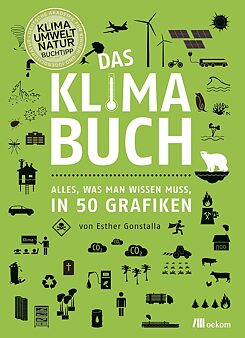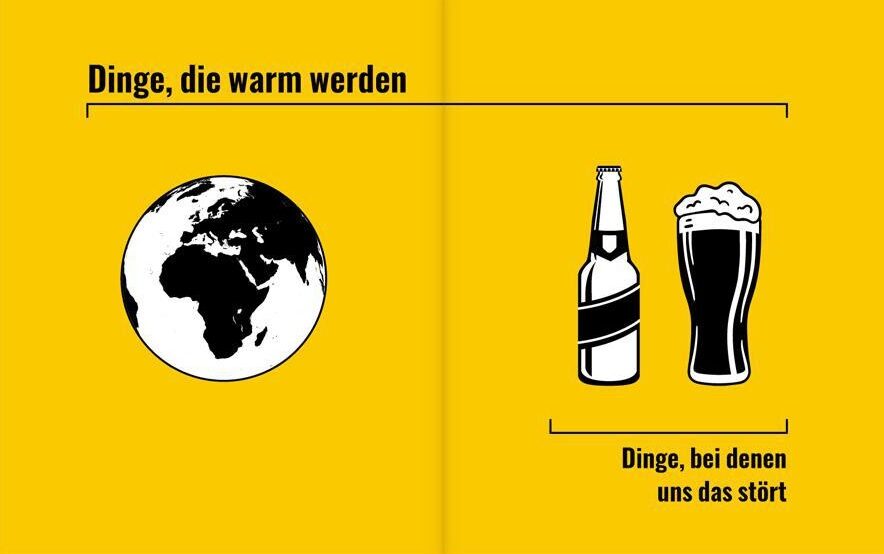Climate change and sustainability
The Climate Pigs Are Us
From non-fiction to picture books, climate change – and what we can do about it – is an issue for publishers.
By Holger Moos
With her Klimabuch (Climate Book), the infographic and book designer Esther Gonstalla aims to depict everything you need to know about the topic in 50 illustrations. And she manages it quite well. The topic can hardly be presented in a more dense and vivid way. After describing the Earth’s climate system and the importance of carbon dioxide in the first section, various diagrams depict humankind’s contributions to climate change. It’s not just about increased human-made greenhouse gas production and the relationship between population growth and CO2, but also about emissions trading, hidden emissions, how the Internet eats up energy, and the clearing of the rainforests and palm oil production.
The third section features infographics on the known consequences of the greenhouse effect, e.g. the rise in extreme weather events, the melting of the polar ice caps and glaciers, the thawing of permafrost, the change in ocean currents, climate wars, water scarcity, climate migration, etc. The last section presents approaches and unfolds a panorama of the various turnarounds that will be necessary to slow down or stop climate change: an energy turnaround, green economic turnaround, agricultural turnaround, transport turnaround. In the end, there are infographics with hopeful examples from around the world as well as tips on what you can do yourself to reduce your carbon footprint.
More mobile phones than toothbrushes
Some time ago, this blog presented 100 Karten, die deine Sicht auf die Welt verändern (100 Maps That Will Change the Way You See the World). KATAPULT magazine has published another book with infographics, 102 grüne Karten zur Rettung der Welt (102 Green Maps to Save the World), which broadens our view of the relationship between humans and the environment.The diagrams are based on the principles of brevity, surprise and humour. For instance, a world map with oceans full of red dots looks like they are soaked in blood. There are only four black dots on the coasts; these are the four people who died in shark attacks in 2018. The countless red dots in the world’s oceans symbolise the more than 100 million sharks killed by humans. And who would have known that there are 8 billion mobile phones being used actively worldwide, but only 3.5 billion toothbrushes?
But once you know everything about the correlations of climate change what can you do? You can demonstrate for political and social change – and you can change your own actions. Many books have also been written on this subject such as Faironomics – Ökologisch, fair und frei (Faironomics – Ecological, Fair, and Free) whose authors Ilona Koglin and Marek Rohde encourage readers to realise a dream project in eight steps. It’s “a mixture of non-fiction, social fiction, and how-to.”
life-as-usual is (not) an option
Ingolfur Blühdorn, professor of social sustainability and head of the Institute for Social Change and Sustainability at the Vienna University of Economics and Business, and other academics take a disillusioned look at our western societies in Nachhaltige Nicht-Nachhaltigkeit (Sustained Non-Sustainability). In the book, Blühdorn and his colleagues explain why the ecological transformation of society is not happening.Contrary to the often expressed sentiment that we cannot go on this way, “precisely this life-as-usual is, in fact, obviously not just an option, but the democratically legitimised priority project of modern consumer societies – regardless of whether it is openly articulated or not”. This “contradictory simultaneity of ‘life-as-usual is not an option!’ and ‘definitely life-as-usual!’” is possible because, apart from minor sacrifices here or there, we don’t want to give up our “imperial lifestyle” at the expense of others and of nature. Life with never-before-seen opportunities to travel, shop, be entertained, and attain self-fulfilment, apparently taken for granted in wealthy countries, is simply too good to give up.
Hence, human self-enlightenment and fundamental social transformation have failed. Blühdorn is also politically sceptical and assumes that the supposedly enlightened and emancipatory-minded citizens are silently “complicit” with the populists who take on the dirty business of marginalisation from which we all benefit.
The narrative picture book Die Klimaschweine (The Climate Pigs) by Julia Neuhaus and Till Penzek reminds us that everything could be quite simple. The fable is about the pigs living in abundance and the frugal penguins at the other end of the world under whom the ice is melting away. So the penguins visit the pigs to tell them about the consequences of their lifestyle. Nonetheless, this project can only be successful once the pigs themselves are affected – just like in real life.
Esther Gonstalla: Das Klimabuch. Alles, was man wissen muss, in 50 Grafiken
München: Oekom Verlag, 2019. 128 S.
ISBN: 978-3-96238-124-0
You can find this title in our eLibrary Onleihe.
102 grüne Karten zur Rettung der Welt
Berlin: Suhrkamp, 2020. 203 S.
ISBN: 978-3-518-47083-1
Ilona Koglin & Marek Rohde: Faironomics – Ökologisch, fair und frei. Wie du in 8 Schritten dein Traumprojekt verwirklichst und damit die Welt veränderst
München: dtv, 2019. 192 S.
ISBN 978-3-423-26221-7
Ingolfur Blühdorn, Felix Butzlaff, Michael Deflorian, Daniel Hausknost, Mirijam Mock: Nachhaltige Nicht-Nachhaltigkeit. Warum die ökologische Transformation der Gesellschaft nicht stattfindet
Bielefeld: transcript, 2019. 334 S.
ISBN: 978-3-8376-4516-3
You can find this title in our eLibrary Onleihe.
Julia Neuhaus & Till Penzek: Die Klimaschweine
Mannheim: kunstanstifter Verlag, 2020
ISBN: 978-3-942795-80-7



